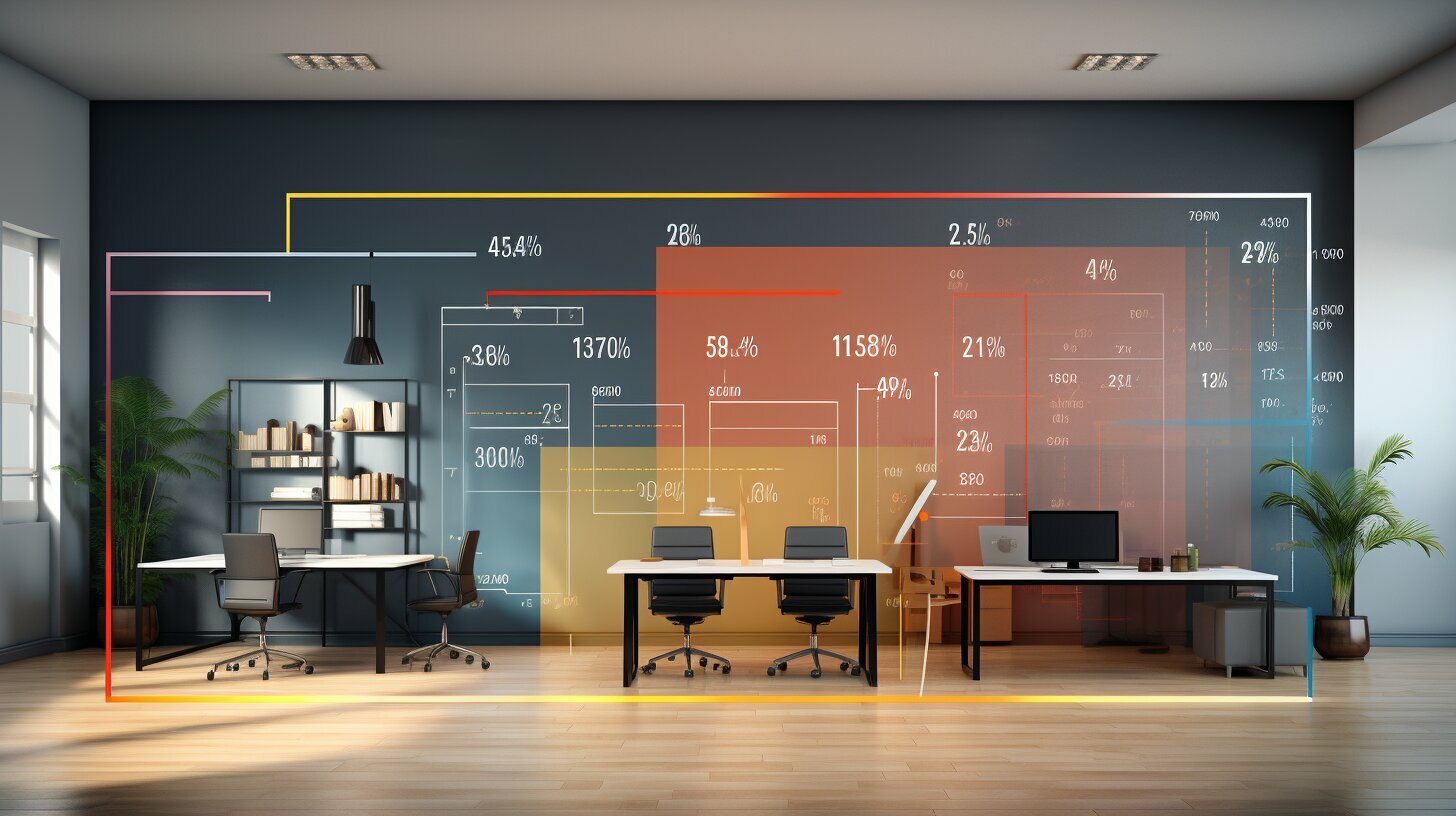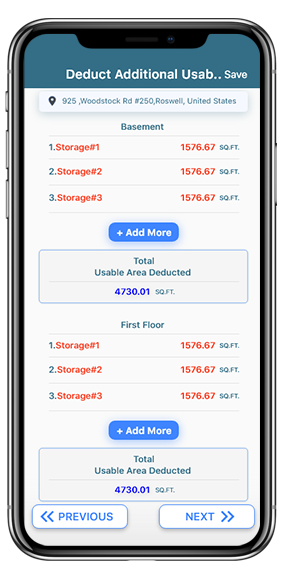If you’re involved in the real estate industry, it’s essential to understand how to calculate usable and rentable square footage. Knowing these measurements can help you make informed decisions and maximize cost-effectiveness, whether you’re a tenant or a landlord. Used in lease agreements and rental costs, accurate calculations of usable and rentable square footage are crucial for both parties.
Key Takeaways:
- Usable and rentable square footage calculations are fundamental in the real estate industry.
- Understanding these measurements can lead to informed decisions and cost-effectiveness.
- Accurate calculations of usable and rentable square footage are crucial for both tenants and landlords in lease agreements and rental costs.
The Difference Between Usable and Rentable Square Footage
Before we delve into the calculations, it’s crucial to understand the distinction between usable and rentable square footage. Usable square footage refers to the area within a space that is exclusively available for your use. It includes offices, meeting rooms, and other dedicated spaces that are available for your business needs. This space is yours to use and control, and you pay rent based on this square footage.
Rentable square footage, on the other hand, includes the usable square footage plus a share of common areas such as corridors, elevators, and restrooms. Rentable square footage calculation is used to determine the square footage that a tenant will pay rent for. This allocation is typically calculated based on the tenant’s percentage of the total building’s square footage.
The difference between these two measurements is critical as it affects both lease agreements and rental costs. When searching for commercial space for lease, it’s essential to understand the terminology and availability of rentable office space. With this knowledge, you can lease suitable commercial space that meets your needs and budget.
Determining Rentable Square Footage
Calculating rentable square footage is crucial for landlords and tenants to determine fair rental costs. Rentable square footage includes usable square footage plus a proportionate share of common areas such as hallways, lobbies, restrooms, and elevators. The allocation of common areas is typically calculated based on the tenant’s share of the entire building’s square footage.
For example, if the tenant occupies 10% of the entire building’s square footage, they will be responsible for paying 10% of the costs associated with the common areas. These costs may include maintenance, utilities, and other shared expenses.
Determining the rentable square footage for a commercial property for rent can be a complex process, but it is important for both landlords and tenants to ensure fair rental costs. By accurately allocating rentable square footage, landlords can set competitive rental rates and attract tenants looking for specific space requirements. Tenants can benefit from paying only for the space they need and avoiding excess rental costs.
Importance of Accurate Calculations
Accurate calculations of usable and rentable square footage are critical for ensuring cost-effectiveness in both property leasing and renting. As a tenant, precise measurements of the necessary space are crucial to avoid paying for excess square footage or leasing too little and hindering productivity. On the landlord side, accurate calculations allow for setting competitive rental rates and optimizing tenant satisfaction through relevant space offerings.
Additionally, accurate calculations of usable and rentable square footage play a significant role in lease agreements, as they impact the allocation of shared expenses, the negotiation of lease terms, and the determination of fair rental rates. A clear understanding of these calculations ensures transparency throughout the leasing process and leads to stronger agreements and smoother tenant-landlord relationships.
Therefore, accurate calculations of usable and rentable square footage are essential for maximizing square footage availability and creating rentable office space for commercial properties in high-demand areas. Inaccurate measurements can lead to dissatisfaction and ultimately impact the bottom line of both tenants and landlords. By incorporating these calculations into the leasing and renting process, you can unlock the full potential of your office space availability in the competitive real estate market.
Maximizing Cost-Effectiveness
Understanding usable and rentable square footage calculations is crucial for maximizing cost-effectiveness in your real estate endeavors. When looking for usable space for lease, it’s important to accurately determine the appropriate amount of square footage needed for your commercial space. By leasing only the amount of space you truly need, you can avoid excess costs and ensure efficiency.
For landlords with commercial space for lease, accurate calculations of usable and rentable square footage can help in optimizing cost-effectiveness. Allocating rentable square footage and optimizing the utilization of common areas can lead to more efficient space planning and resource allocation.
Consider utilizing flexible square footage when leasing commercial space. This approach can provide versatility in space utilization and can lead to significant cost savings for both tenants and landlords. With accurate and efficient space planning, you can optimize cost-effectiveness and achieve success in your real estate endeavors.
Incorporating Vertical Shafts and Other Considerations
While calculating usable and rentable square footage, it’s essential to consider vertical shafts such as elevator shafts and staircases. These spaces are usually excluded from usable square footage but may be included in rentable square footage calculations. Additionally, other areas with low ceiling heights or use restrictions may impact the calculations. Accurate measurements ensure that your usable and rentable square footage reflects your actual needs.
When determining usable space for lease, calculating rentable office space, or assessing square footage availability for commercial space for lease, factoring in vertical shafts and other considerations is crucial. By doing so, you can ensure that you’re accurately measuring your square footage needs, avoiding unexpected costs, and finding the right space for your business.
The Impact on Lease Agreements
Usable and rentable square footage calculations play a significant role in lease agreements. You rely on accurate measurements to determine rental rates, negotiate lease terms, and allocate shared expenses. Without precise calculations, there is a risk of overcharging or undercharging for the the space. Additionally, incorrect measurements can result in tenant dissatisfaction, leading to disputes and lease terminations.
When leasing commercial space for rent or looking for rentable office space, ensuring accurate square footage availability measurements is crucial. Reliable measurements ensure both parties feel confident in their lease agreement and can work together towards a successful and profitable tenancy.
The Importance of Professional Assistance and Technology Tools
Calculating rentable space and commercial property for rent can be complex, especially for large commercial properties. Seeking professional assistance from real estate experts or utilizing technology tools specifically designed for these calculations can streamline the process and ensure accuracy. Without professional assistance, errors can be made, leading to inaccurate measurements and financial losses.
The benefits of using technology tools for rentable office space calculations include faster processing times, reduced errors, and better visualization of the data. Professional real estate experts can provide valuable insights into market trends, best practices, and potential pitfalls to avoid. They can also assist in the negotiation of lease agreements and provide guidance throughout the leasing process.
Whether you are a tenant looking for the perfect office space availability or a landlord seeking to maximize returns, seeking professional assistance can result in cost savings, optimized space utilization, and more successful real estate transactions.
The Benefits of Optimizing Square Footage
By understanding and maximizing usable and rentable square footage, you can unlock numerous benefits for both tenants and landlords. Here are just a few:
- Cost savings: Leasing only the necessary amount of space can significantly reduce costs for tenants. For landlords, optimizing space usage can lead to lower maintenance and utility expenses.
- Improved productivity: An efficiently designed space can enhance employee productivity and satisfaction.
- Increased rental income: Landlords can earn higher rental income by accurately allocating rentable square footage and pricing it competitively.
- Better tenant retention: By providing tenants with the ideal amount of space and amenities, landlords can improve tenant satisfaction and retention rates.
- Competitive advantage: Optimizing square footage gives landlords a competitive edge in the market, making it more attractive to tenants.
Whether you are a tenant or a landlord, optimizing square footage is crucial to maximize cost-effectiveness and success. By accurately measuring usable and rentable space and implementing efficient space planning, you can unlock the full potential of your commercial property or office space.
The Future of Usable and Rentable Square Footage Calculations
As the workplace continues to evolve, so do the dynamics of commercial real estate. With remote work becoming more prevalent, the demand for flexible commercial spaces is on the rise. This trend is creating a need for more accurate and adaptable square footage calculations to provide tenants with the right amount of space at the right time.
In addition, technological advancements are transforming traditional office spaces into smart and interactive environments. This shift is driving the need for more sophisticated measurement and allocation of rentable square footage to accommodate new technologies like artificial intelligence and the Internet of Things.
As the demand for commercial space increases, the availability of square footage for lease becomes a crucial consideration. Developers and landlords need to be mindful of the changing demand for space and provide adaptable solutions. Adopting modern approaches to square footage calculations, such as utilizing virtual reality and AI tools, can help property owners stay competitive and attract tenants in the ever-changing commercial real estate market.
Conclusion
As a tenant or landlord in the real estate industry, calculating usable and rentable square footage is crucial. By understanding the difference between the two and accurately determining the measurements, you can make informed decisions to maximize cost-effectiveness and attract the right tenants.
Incorporating calculations for vertical shafts, low ceiling heights, and specific use restrictions can ensure accuracy. Additionally, seeking professional assistance or utilizing technology tools can streamline the process and prevent errors.
Optimizing square footage through efficient space allocation offers numerous benefits, including cost savings, increased rental income, and improved tenant retention. Regularly assessing and adjusting your square footage needs can help you stay ahead of industry trends and evolving workplace dynamics.
Whether you are a tenant looking for the perfect space or a landlord seeking to maximize returns, incorporating usable and rentable square footage calculations into your real estate endeavors will lead to better outcomes and increased success.
Now that you’ve learned about the importance of understanding usable and rentable square footage calculations in the real estate industry, it’s time to take action. Download the U/R Simple App to simplify your calculations and make informed decisions about your commercial property needs.
With the U/R Simple App, you can easily calculate usable and rentable square footage, ensuring cost-effectiveness and maximizing the potential of your office space. Don’t miss out on this valuable tool that can help you navigate the complexities of commercial real estate and optimize your leasing and renting processes. Download the U/R Simple App today and unlock the full potential of your commercial property endeavors.




